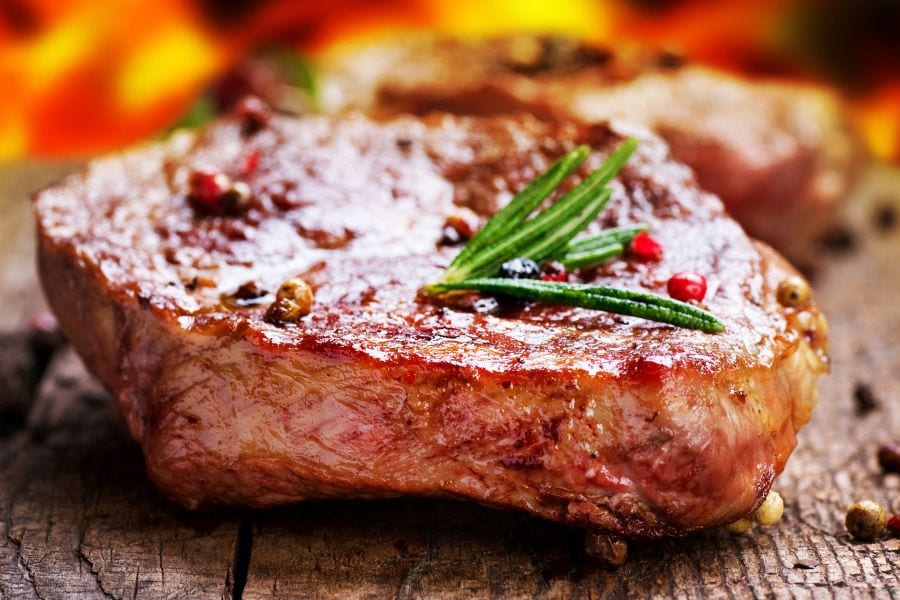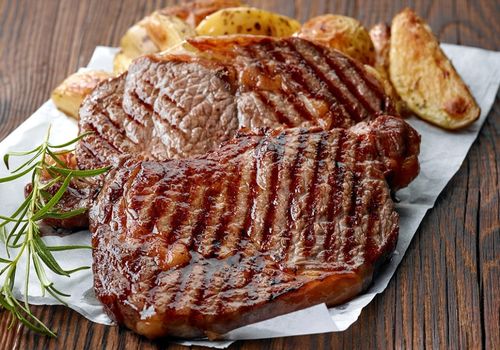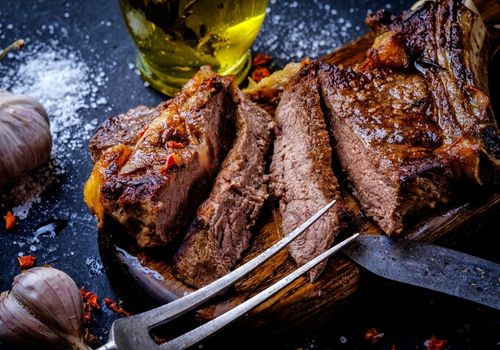The rule of thumb for me is that the rest time should be at least one-third of the cooking time. So if you’ve grilled a nice, thick steak (first browned over direct heat, then cooked over indirect heat) for about 15 to 20 minutes, it should be allowed to rest for at least 5 to 7 minutes to have the perfect steak.
Still, this is a contested topic among meat fans. To rest or not to rest? And if so, for how long? I get asked this question often. In today’s topic, I’ll try my best to answer it, using my experience with steak preparation and meat tasting. I’ll also provide some guidelines for resting steaks.

Whether you’re roasting or grilling steaks, the optimal average time for resting meat is 10 minutes. This is how you have a juicy steak!
But it all depends on the size of the roast. For bigger roasts, the resting period can reach 20 minutes.
This is why I mentioned letting the steak rest for one-third of the cooking time. Of course, don’t forget to factor in the size of the steak.
Giving a specific rest time is almost impossible because too many factors go into it. These include breed, gender, age at slaughter, maturation method, and grilling temperature, to name a few.
If an internal temperature probe or meat thermometer is used, which I definitely recommend, it should remain in the meat even when it rests.
The rest time ends when the core temperature no longer rises. Then, the temperature in the whole piece of meat has evened out. There will no longer be a place for the meat’s juices to pool and are circulate.
It’s simple. Stop the grill, place the meat on a platter and let it rest for the desired time. You may also wrap the meat in aluminum foil or cover it up.
When the steak is removed from the grill, the temperature that affected the steak from the outside will work its way further into the middle.
The heat is stored in the crust and will also radiate inwards in the following minutes. That means the meat is still cooking.
If you compare two steaks directly – one that has just come off the grill and one that has rested for a few minutes – you can see that the rested piece is flatter.
So it is also more relaxed. This indicates that the meat juices were able to redistribute evenly.
I recommend setting the core temperature probe at 15 below the desired target temperature. The steak will gain the remaining 15 when it rests, and you’ll have a degree-precise landing at the desired core temperature.
Small cuts of meat like chicken breasts will cook for 3 to 6 degrees Fahrenheit and larger cuts like pork tenderloin and turkey can cook for 10 to 15 Fahrenheit.

The question has not been scientifically answered. Meathead Goldwyn’s book, The Science of Great Barbecue and Grilling, even says there is no measurable difference in meat juice loss, regardless of whether you let it rest or cut the steak immediately after grilling.
However, I have a different opinion which I can prove. From my experience and with the knowledge of the structure of a muscle and the biomolecular processes during cooking, it makes sense to me to let the steak rest.
If you cut the meat immediately after roasting, the released water will spill onto the plate. However, if the meat is left to rest, the muscle strands relax and bind some of the water they release during roasting. That means: meat should be left to rest in any case.
Meat consists mainly of water. It contains – in addition to proteins and fat – about 75% water.
If you cut open a piece of raw meat, no water flows out. But if you cut up a fried piece – directly from the hot pan – then a copious stream of meat juice spills onto the plate.
How is this so?
The answer: muscles!
Meat is made up of muscle fibers. The proteins, which make up the bulk of muscle mass, hold the water in the raw cut of meat.
When meat is exposed to high temperatures, you’ll have constricted muscle fibers with water squeezing out of their structure.
The water collects between the muscle strands. Incidentally, this contraction of the muscle strands also means that the meat becomes noticeably firmer, and you can determine the cooking point fairly precisely by pressing your finger on the meat.
Related Reading
I have an assignment for you, and I hope you try it out. This is an experiment that is as unconventional as it is impressive.
Roast two steaks as identically as possible (same piece, same weight) to the same core temperature. Then take the steaks out of the pan.
Place the first steak on a tray. Then, press on the meat with your palm as much as you can. Measure or observe how much meat juice escapes.
As for the second steak, let it rest under aluminum foil for 10 minutes and only then put it in a bowl. Press it and measure the amount of juice that escapes.
The likely result: While you’re able to squeeze a lot of liquid out of the first steak, the skin of the rested steak will remain almost dry. Not much juice will escape and you’ll have a flavorful steak!

Covering or wrapping meat during resting allows the meat to continue cooking. So you should be careful or you may end up with an overcooked steak.
Covering is a great technique for those who cook below the recommended temperature (around the medium rare cooking range) and want the steak to continue cooking during resting.
Covering or wrapping also helps you avoid having a cold steak before cutting or serving.
Letting the meat run cool cold turkey by placing it on a cutting board may impact the structure or texture of the meat. So you may have a drier and chewy steak by leaving it uncovered on a cutting board.
Meanwhile, covering it when you have a medium rare can help you have tender and juicy steak. The heat dissipates slowly, and the fibers are relieved from heat gradually. However, if you have to uncover it, a trick I use is to place it on a warm plate.
Related Reading
There’s no doubt why you need to let the meat rest. 10 to 20 minutes is the ideal range to have a perfect steak. But you can also make do with the one-third cooking time formula.
If the meat is cut immediately after cooking, the juice will flow onto the plate. As a result, it appears drier and less juicy, and the beefy flavor may be missing.